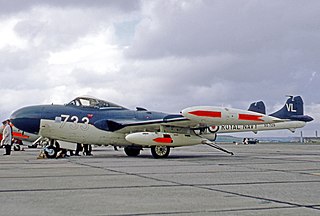 W
WThe Avro 720 was an in-development British single-seat interceptor of the 1950s. It was designed and being developed by Avro in competition with the Saunders-Roe-built SR.53. While at least one prototype was partially-constructed, the order for the Avro 720, and quickly thereafter the project entirely, was terminated prior to any aircraft having been completed.
 W
WThe de Havilland Sea Venom is a British postwar carrier-capable jet aircraft developed from the de Havilland Venom. It served with the Royal Navy Fleet Air Arm and with the Royal Australian Navy. The French Navy operated the Aquilon, a version of the Sea Venom FAW.20 licence-built by SNCASE (Sud-Est).
 W
WThe de Havilland DH.110 Sea Vixen is a British twin-engine, twin boom-tailed, two-seat, carrier-based fleet air-defence fighter flown by the Royal Navy's Fleet Air Arm during the 1950s through to the early 1970s. The Sea Vixen was designed by the de Havilland Aircraft Company during the late 1940s at its Hatfield aircraft factory in Hertfordshire, developed from the company's earlier first generation jet fighters. It was later called the Hawker Siddeley Sea Vixen after de Havilland was absorbed by the Hawker Siddeley Corporation in 1960.
 W
WThe English Electric Lightning is a British fighter aircraft that served as an interceptor during the 1960s, the 1970s and into the late 1980s. It remains the only UK-designed-and-built fighter capable of Mach 2. The Lightning was designed, developed, and manufactured by English Electric, which was later absorbed by the newly-formed British Aircraft Corporation. Later the type was marketed as the BAC Lightning. It was operated by the Royal Air Force (RAF), the Kuwait Air Force (KAF) and the Royal Saudi Air Force (RSAF).
 W
WThe Folland Gnat is a British compact swept-wing subsonic fighter aircraft that was developed and produced by Folland Aircraft. Envisioned as an affordable light fighter in contrast to the rising cost and size of typical combat aircraft, it was procured as a trainer aircraft for the Royal Air Force (RAF) as well as by export customers, who used the Gnat in both combat and training capacities.
 W
WThe Gloster Javelin is a twin-engined T-tailed delta-wing subsonic night and all-weather interceptor aircraft that served with Britain's Royal Air Force from the mid-1950s until the late 1960s. The last aircraft design to bear the Gloster name, it was introduced in 1956 after a lengthy development period and received several upgrades during its lifetime to its engines, radar and weapons, which included the De Havilland Firestreak air-to-air missile.
 W
WThe Hawker Hunter is a transonic British jet-powered fighter aircraft that was developed by Hawker Aircraft for the Royal Air Force (RAF) during the late 1940s and early 1950s. It was designed to take advantage of the newly developed Rolls-Royce Avon turbojet engine and the swept wing, and was the first jet-powered aircraft produced by Hawker to be procured by the RAF. On 7 September 1953, the modified first prototype broke the world air speed record for aircraft, achieving a speed of 727.63 mph.
 W
WThe following is a list of variants of the Hawker Hunter fighter aircraft:
 W
WThe Hawker P.1081, also known as the "Australian Fighter" was a prototype British jet aircraft from the mid-twentieth century. The single example built was destroyed in a crash in 1951.
 W
WThe Hawker P.1121 was a British supersonic fighter aircraft designed, but never fully completed, by Hawker Siddeley during the mid-1950s. It was designed by a team headed by Sir Sydney Camm.
 W
WThe Hawker Sea Fury is a British fighter aircraft designed and manufactured by Hawker Aircraft. It was the last propeller-driven fighter to serve with the Royal Navy, and one of the fastest production single reciprocating engine aircraft ever built. Developed during the Second World War, the Sea Fury entered service two years after the war ended. It proved to be a popular aircraft with a number of overseas militaries, and was used during the Korean War in the early 1950s, as well as against the 1961 Bay of Pigs Invasion of Cuba.
 W
WOperational Requirement F.155 was a specification issued by the British Ministry of Supply on 15 January 1955 for an interceptor aircraft to defend the United Kingdom from Soviet high-flying nuclear-armed supersonic bombers.
 W
WThe Saunders-Roe SR.53 was a British prototype interceptor aircraft of mixed jet and rocket propulsion developed for the Royal Air Force (RAF) by Saunders-Roe in the early 1950s. As envisaged, the SR.53 would have been used as an interceptor aircraft, using its rocket propulsion to rapidly climb and approach incoming hostile bombers at high speeds; following its attack run, the aircraft would be able to return to its base by making use of the secondary jet propulsion instead.
 W
WThe Saunders-Roe SR.177 was a 1950s project to develop a combined jet- and rocket-powered interceptor aircraft for the Royal Air Force (RAF) and Royal Navy. It was an enlarged derivative of the Saunders-Roe SR.53, which was itself an experimental combined jet-and-rocket interceptor aircraft.
 W
WThe Supermarine Type 525 was a British prototype naval jet fighter aircraft of the 1950s.
 W
WThe Supermarine Scimitar was a British naval strike aircraft operated by the Royal Navy Fleet Air Arm. The prototype for the eventual production version flew in January 1956 and production aircraft were delivered in 1957. It saw service with the Royal Navy from 1958 until 1969, replaced in service by the Blackburn Buccaneer.
 W
WThe Supermarine Swift is a British single-seat jet fighter aircraft that was operated by the Royal Air Force (RAF). It was developed and manufactured by Supermarine during the 1940s and 1950s. The Swift featured many of the new jet age innovations, such as a swept wing. On 26 September 1953, a Swift F.4 piloted by Commander Mike Lithgow broke the world absolute speed record, reaching a speed of 737.7 mph (1,187 km/h).
 W
WThe Vickers Type 559 was a supersonic interceptor aircraft design by the British aircraft company Vickers-Armstrongs and was their submission for Operational Requirement F.155 in 1955.